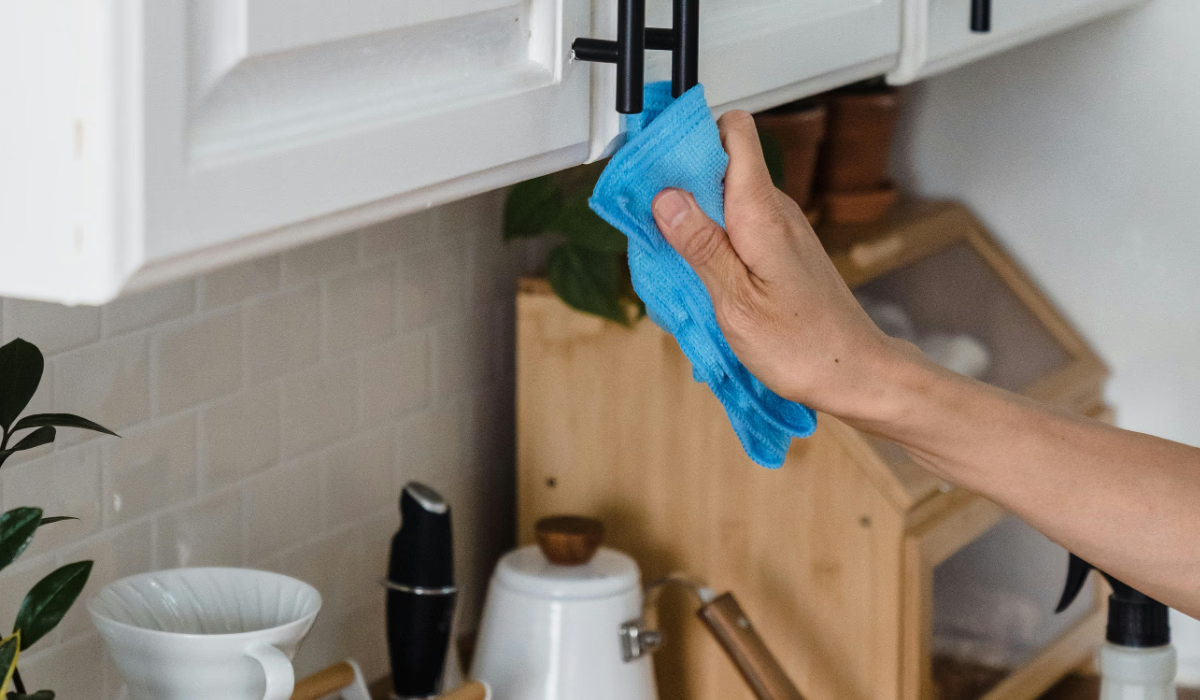Kitchens are high-traffic zones. Between cooking, eating, spills, and daily habit, surfaces and utensils get messy quickly. Without good strategies, cleanup feels endless. But with the right tricks and preventive habits, you can cut the effort dramatically and keep your kitchen feeling fresher longer.
Declutter First, Then Wipe
Before you begin wiping surfaces, remove clutter: jars, utensils, mail, small appliances that don’t need sitting out. Clearing that visual noise makes the work of cleaning easier. Once the counters are cleared, wiping down is faster because you’re not working around obstacles or moving things back and forth constantly.
Soak While You Cook
One clever trick is to let stubborn pots, pans, or oven racks soak while you finish other tasks. Loosened grime becomes easier to scrub later. This reduces aggressive scrubbing time after cooking and prevents buildup from sticking harder over time.
Clean Top Down to Avoid Re-Soiling
Start cleaning from higher areas—tops of cabinets, lighting fixtures, the vent hood—and gradually work your way to counters, then floors. That way, dust, grease, or dirt doesn’t fall onto freshly cleaned surfaces. This order helps you avoid doing the same surface twice and saves time.
Tackle Dishes Immediately
Leaving dirty dishes sitting in the sink or stacked around the kitchen drags your cleanup longer. Wash or load the dishwasher as soon as possible after meals. The sooner dishes are out of the way, the less visual mess there is, and the less grease or food residue has time to harden.
Refresh Smells Quickly
Sometimes a kitchen feels messy because of lingering odors more than visible dirt. You can reset the perception of cleanliness by cutting a lemon and tossing it down the garbage disposal, lighting a scented candle, or using a light spritz of your favorite scent. Resetting scent helps the space feel clean faster, even before the deep scrubbing is done.
Make Cleanup Part of Cooking
Rather than postponing cleaning until after everything’s done, weave small cleaning moves into the cooking process. Rinse utensils you’re done with, wipe down splattered areas immediately, put ingredients back as you use them, and wash a little between cooking steps. This distributed approach prevents a huge pile of mess waiting after.
One Big Clean, Less Frequent
By maintaining cleanliness daily with the above tricks, your deeper clean sessions get shorter. Less “catch up” work means weekly or monthly deep cleans are manageable. If surfaces stay relatively clean, tasks like scrubbing grease or cleaning behind appliances become less daunting rather than overwhelming.
Conclusion
The constant “wipe, wipe, wipe” feeling can be tamed by clever strategies: clear off clutter first, soak while you cook, clean from top to bottom, handle dishes immediately, and refresh smells. Integrating small habits into your cooking routine shifts the burden away from major cleanup marathons. Over time, you’ll find your kitchen stays cleaner with less effort, and those dreaded full cleans don’t feel as overwhelming.
FAQs
How often should I do a full kitchen deep clean?
A deeper clean weekly or biweekly is common—depending on how much you use your kitchen—but daily upkeep makes that more realistic and less time consuming.
What’s the easiest way to handle greasy stove surfaces?
Wipe spills promptly. For tougher grease, let a degreasing solution or warm soapy water sit briefly before wiping. That reduces scrubbing.
Can natural products like lemon or baking soda help?
Yes—they work well for light stains, deodorizing, and as gentle abrasives. But for heavy grease or baked-on messes, stronger cleaners or soaking may be needed.
Is it okay to skip wiping daily?
Skipping daily wipes leads to buildup of grime, which hardens and becomes harder to clean later. Small daily actions prevent a mountain of work.
How do I keep the kitchen smelling fresh between deep cleans?
Use lemon in the garbage disposal, leave a bowl of vinegar or baking soda to absorb odors, keep trash sealed, and clean drain or trash bin odors regularly.







